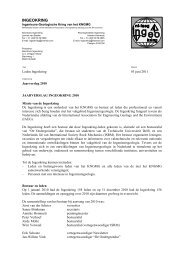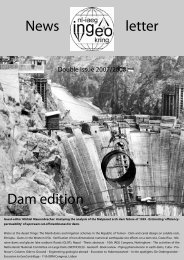environment
environment
environment
- No tags were found...
Create successful ePaper yourself
Turn your PDF publications into a flip-book with our unique Google optimized e-Paper software.
Vol. 11 No. 1 2004<br />
1.Visual inspections through a logical reasoning system<br />
of an expert having a good geological knowledge of the<br />
area and /or comparison of the made models with an<br />
existing references data set. Especially user-defined<br />
modelling objectives can help and ensure that the final<br />
model output is compatible with its intended<br />
applications.<br />
2. A conceptual design of reliability assessment<br />
methodology is proposed to select or rank (in terms of<br />
reliability) the models based on the quantification of<br />
the input parameters, such as data quality, interpretation<br />
quality and quality of modelling algorithms. The<br />
evaluation of the likelihood of a model requires<br />
conversion of the subjective reasoning or logic to<br />
mathematical computation, to obtain a likelihood index.<br />
This is executed in a four-step process.<br />
- Step 1: To define the modelling objectives properly<br />
and establish the standard format which can satisfy<br />
the idea of professional experts<br />
- Step 2:To gather the opinions from different<br />
professional experts by questionaries<br />
- The third step is to organize different opinions<br />
systematically and assign the weighting score for<br />
each parameter either by the verbal method or<br />
statistical methods<br />
- The fourth step is to sum up the reasoning result<br />
from the data quality, interpretation quality and<br />
modling parameters, and give the final ranking of<br />
the model.<br />
In this resarch ,the second part is not fully covered<br />
because it requires a lot of time and resources.<br />
Abstract thesis Ruena<br />
Mendoza<br />
ITC<br />
Determination of Lateral Stresses in Boom Clay<br />
The Boom Clay formation is a well-studied deposit in<br />
terms of its geotechnical and geological properties.<br />
These studies are in line with the projects such as the<br />
WesternScheldt tunnel, the nuclear disposal site in Mol,<br />
Belgium, Western Scheldt barrier and other related<br />
projects in Belgium as well as in the Netherlands. It is a<br />
tertiary deposit that is outcropping in the Northeastern<br />
part of Belgium. This clay is a deposit that is known of<br />
not being overrun by glaciers as contrary to the Pot<br />
Clay that are being pushed by the glaciers during the<br />
ice age.<br />
clay is used in Boom Clay to test the isotropy/anisotropy<br />
of its lateral stresses. There have been few modifications<br />
on this lateral stress oedometer, so together with the<br />
testing of Boom Clay, assessment of these modifications<br />
is also considered.<br />
The soil specimen used in conducting the test using<br />
the lateral stress oedometer is Boom Clay that is<br />
extracted from the WesternScheldt area. Four samples<br />
tube are being used in the laboratory test and each of<br />
the test displays anisotropy with respect to the three<br />
points that are 120° apart from each other. The<br />
anisotropic lateral stress oedometer was designed<br />
(Hegterman, 2003) such that it will be able to keep track<br />
of the lateral stresses of these three points in response<br />
to the vertical load applied to the soil. Such lateral stress<br />
oedometer functions the same as the standard<br />
oedometer with additional feature of being able to<br />
determine the isotropy/anisotropy of the soil specimen.<br />
Assessment of the stress history of the Boom Clay will<br />
be determined from the result of the lateral stress<br />
oedometer. The tests results suggest that the Boom<br />
Clay has some degree of anisotropy with respect to its<br />
response to the applied vertical load and it seems there<br />
is anisotropic stiffness of the deposit in its horizontal<br />
plane. As compared to the Potclay, the degree of<br />
anisotropy in Boom Clay is less than that of the Potclay<br />
(Hegtermans, 2003). The values suggest that the<br />
magnitude of the anisotropy of the Boom Clay is lesser<br />
than that of the deposits overrun by glaciers.<br />
According to Schokking et. al. (1995), the Boom Clay in<br />
the Western Scheldt has fissures that are due to stress<br />
relief during tectonic uplift and subsequent erosion<br />
while Dehandschutter et al.(in press) concluded that<br />
these fractures of the Boom Clay at Mol and Antwerp is<br />
of regional importance and these fractures are results<br />
of the combination of compaction and consolidation as<br />
well as uplift and bending. The anisotropic stiffness in<br />
its horizontal plane of the Boom Clay in Western Scheldt<br />
can probably be due to the uplift and flexure or bending<br />
of the deposit in such area which seems to agree with<br />
the results of Dehandschutter.<br />
At the beginning of this research project, it was assumed<br />
that such formation is cross-anisotropic due to its stress<br />
history that is primarily compose of deposition and<br />
erosion. In the present research study, the lateral stress<br />
oedometer used to determine the anisotropy of the Pot<br />
65




